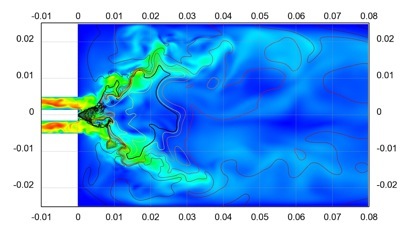Research: Spray Modeling
Lagrangian and Eulerian Spray Modeling
Sprays and other dispersed-phase systems can be described by a kinetic equation containing terms for spatial transport, acceleration, and particle processes (such as evaporation or collisions). In principle, the kinetic description is valid from the dilute (non-collisional) to the dense limit. However, its numerical solution in multi-dimensional systems is intractable due to the large number of independent variables. As an alternative, Lagrangian methods "discretize" the density function into "parcels" that are simulated using Monte-Carlo methods.

While quite accurate, as in any statistical approach, Lagrangian methods require a relatively large number of parcels to control statistical noise, and thus are computationally expensive. A less costly alternative is to solve Eulerian transport equations for selected moments of the kinetic equation. However, it is well known that in the dilute limit, Eulerian methods have great difficulty describing correctly the moments as predicted by a Lagrangian method. A two-point quadrature-based Eulerian moment closure was developed and tested for the Williams spray equation. It was shown that this method can successfully handle highly non-equilibrium flows (e.g., impinging particle jets, jet crossing, particle rebound off walls, and homogeneous isotropic turbulence) that heretofore could not be treated with the Eulerian approach. This approach will be the basis of future Eulerian model development, and will need to be extended to multiple-point quadrature, evaporation, collisions. Future work will also include the development of an LES formulation.
Turbulent Spray Combustion
In gas turbine engines, liquid fuel must first evaporate before it can be consumed by combustion. Hence, liquid atomization and vaporization is of paramount importance in combustion systems, and governs how fuel is supplied to the flame. A key element in predicting the complex behavior of gas turbine engines is therefore accurately modeling spray evaporation. Indeed, in reacting multi-phase flows the combustion process is intricately linked to spray evaporation. The energy required by the phase change is provided by the heat of combustion, and the fuel consumed by the flame comes from liquid vaporization creating a complex sub-filtered mixing field.

A complex flame structure including premixed and diffusion combustion regions has been observed in preliminary simulations, which confirms the need for an adequate partially premixed combustion model. Results of preliminary studies have shown that typical gaseous combustion models may not be able to adequately describe multi-phase reacting flows. The scalar dissipation rate appears to be significantly modified by the presence of the spray, and this should be reflected in the combustion model.

